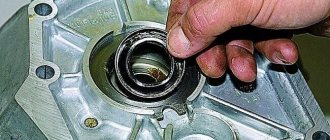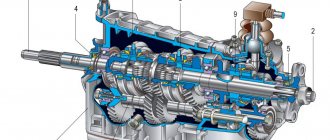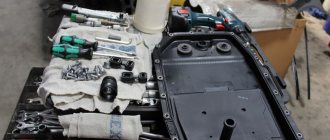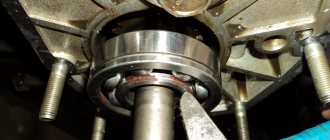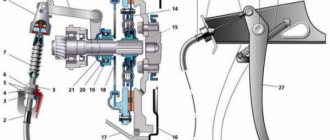How to change gears on an ATV
Any wheeled vehicle - from a bicycle to a multi-ton truck - has a transmission in its design: a system that transmits rotation from the engine to the wheels. The operation of the transmission - and therefore the driving speed - can be controlled by changing gears.
In each type of transport, gear shifting is organized differently. In the article below we will tell you exactly how to change gears on ATVs, and what gearboxes are found on such equipment.
How does a gearbox work on an ATV?
Let's give an example of how a manual transmission works, because it may work differently from other equipment. The main component is the gearbox; its force is transmitted from the second shaft with the variator pulley to the third shaft - the intermediate shaft. It is this that allows the box to continue operating, transmitting force to the last 4th shaft with the wheel mounted on it. All the described design parts are located inside the protective casing, and the constant presence of oil in the system allows the lifespan to be increased.
Try to monitor its level, otherwise the transmission will soon break down. If you choose 250cc ATVs, the price with driveshaft will be a little different from others. In any case, you will have to consult with the seller, who will select an ATV to suit your needs.
Types of gearboxes for ATVs and a list of gears in them
Gearboxes for ATVs can be of two types:
Rarely and mainly in older models, but other variations can be found. For example, an “automatic” with the ability to manually change gears.
ATVs with manual transmission are a little more difficult to drive (at least at first, until the habit develops), but you can more accurately select the appropriate mode. And vice versa: CVT “boxes” are much easier to use, they are easy to master for a beginner who gets behind the wheel of an ATV for the first time. But when actively driving along a route with variable difficulty, driving a CVT will be a little less convenient.
For example: you are driving on a flat, compacted dirt road on H, and you see a large section of muddy road ahead with deep mud (or a steep incline, or bumps, or rocks). You will have to come to a complete stop and switch to L, drive through the mud, and when you get back onto a dry road, you will have to completely stop again and switch back to H.
First ATV: making the right choice
Manufacturers realized long ago that different ATVs are needed and different ones are important, and not just waves, but real tsunamis of all kinds of models and shapes poured into the ATV market. Fortunately, most manufacturers are from those countries where they are familiar with tsunamis firsthand; however, this is not important, the important thing is that when choosing our first ATV, many of us risk getting lost in the possibilities opening before our eyes.
1. Type of ATV. Since many people base their idea of ATVs on advertising, and advertising usually promotes expensive sports models, most clients want to buy just such a powerful, fast sports model. However, a sport ATV is not the best choice for your first purchase. The fact is that they are developed for competitions and races, which means for already quite experienced drivers, but a beginner who gets behind the wheel of such an all-terrain vehicle for the first time will be quite uncomfortable. Start with a utilitarian or recreational model, this may keep you from doing risky, hair-raising stunts at first.
2. Engine size. If you have previously only seen an ATV in a picture in a glossy magazine, do not rush to buy an ATV with a large engine capacity. Size, of course, matters, but at first you will have difficulty coping with a 150 cc engine at full power, so it’s better don't rush to the cubicle. For many, the first ATV is remembered for the huge number of accidents and rollovers that are inevitable during training, but which will not be so painless at low speeds. And it wouldn’t be such a shame to crash a small, inexpensive Stels 50 ATV. For the first experiments, a 50 cc quadric will be enough.
1. Gearbox - there are automatic, manual and semi-automatic. If you don’t have experience shifting gears while simultaneously squeezing the clutch and adding gas—yes, all three actions will need to be done simultaneously with just two hands—don’t bother with a manual transmission and buy an ATV with automatic transmission. Those who say that the automatic is insufficiently dynamic and it is impossible to perform cool tricks rarely reach the second pillar.
3. Reverse. A very convenient thing, especially in those days. When you do not yet know how to predict the condition of the road without first poking it with a stick, at first you will quite often get stuck in places where it is no longer possible to move forward. At such moments, the best solution would be to engage reverse and drive into a dry place in reverse.
Shifting gears on a manual transmission of an ATV
ATVs with manual transmissions have a foot lever on the left to change gears, like motorcycles, and a manual clutch lever on the handlebars on the left.
The foot lever device can be of two types:
The switching itself is performed in the same way as on motorcycles:
When exactly to switch speeds up and down is determined by the tachometer, driving speed, road complexity, the weight of the load taken and the characteristics of the ATV itself (power, weight).
ATV manual transmission
The mechanics are identical to the standard motorcycle and allow the driver to more accurately feel the moment of changing gears at the optimal pace. As a result, such sports ATVs have better power and cross-country ability. And when you're cruising on the highway, the power can be reduced by adjusting the gearing. And finally, the last advantage of a manual sports transmission is the ability to corner more comfortably. But try not to change gear directly while turning, otherwise you will lose your balance. The gearbox of 150 cc engines is usually made as simple as possible, so you can’t expect excellent sensitivity and smoothness. The main advantages of mechanics on an ATV can be considered:
Also, changing gears on such a box is much easier than on a motorcycle, because such equipment has 4 wheels, which means that all the emphasis can be placed on controlling the gear shift. Driving with a manual transmission is similar to other manual transmission vehicles, only when driving up a hill you will have to simultaneously hold the clutch and brake.
Therefore, if you are choosing a model for the most dynamic and confident operation, pay attention to the type of transmission; manual will be the best choice.
Changing gears on a variator
CVT gearboxes are much more common in ATVs. There is no need to squeeze the clutch in them, and the forward driving “mode” is selected from two (most often) options: in high gear (suitable for driving along a simple route) or in low gear (for difficult sections, steep climbs and towing).
An important difference from driving a manual transmission: switching between L and H is carried out only when the ATV comes to a complete stop, with the brake depressed. To select a mode, you need to move the knob to the desired position. Switching between L and H on the go is not possible.
The remaining gears - park, neutral and reverse - naturally also turn on when the ATV is standing still.
Source
How much adrenaline is in your blood
That is, the faster you want to go, the higher the gear you will have to engage. In the case of an automatic transmission on an ATV, you will still have to change gears, such as reverse gear or choose between 2D or 4D drive. In inexpensive models, including those made in China, the equipment is equipped with an automatic transmission, but more expensive sports ATVs are equipped with a fully manual transmission.
Safety instructions and rules for operating an ATV
Before you drive the ATV, please read these instructions carefully. It contains important safety and usage information. Based on general safety requirements, you are responsible for the safe operation of the vehicle. It is impossible to prevent all possible injuries associated with driving a vehicle, so you should always use common sense.
1. Persons over 16 years of age and weighing less than 111 kg are allowed to operate an ATV. Children under 16 years old can only ride as passengers.
2. Always follow the instructor's instructions!
(it is not recommended to ride ATVs in shorts and/or shirts or short-sleeved T-shirts). It is prohibited to operate an ATV without an appropriately sized safety helmet. You must also wear eye protection (a protective mask or goggles).
Where and how to get a license for an ATV
How to get a license for an ATV? Very simple! You must be over 16 years old, meet medical requirements, undergo training in an organization that has the appropriate programs and equipment, and pass an exam to obtain a tractor driver's license.
Education
Whether you have to undergo training or not depends only on you. Gostekhnadhor, unlike the State Traffic Safety Inspectorate, provides freedom of choice in this matter:
- You can undergo training at Gostekhnadzor or at one of the sites where it is possible to obtain a tractor driver’s license. Ordinary driving schools do not have programs or permission to train tractor drivers. The course here is not as long as the classic period of learning to drive a car - from 2 weeks to 1.5 months. However, if you already have permission to operate any other self-propelled vehicle, then the theoretical lessons can be shortened by undergoing retraining rather than training;
- You can study the theoretical foundations and prepare to take the practical part on your own. It is also possible, when taking an external exam, to pay only for practical hours of classes (as many as required). It's better to take them. Now I'll tell you why.
Exam
To be admitted to the exam, you must submit the following documents to the Gostekhnadzor inspector:
- Statement;
- Passport;
- Medical certificate confirming the ability to drive a self-propelled vehicle;
- Receipt of payment of the state duty (500 rubles for a tractor driver’s license on a paper basis, 2 thousand rubles for a plastic one);
- 2 photos;
- A certificate of another type for driving self-propelled vehicles (if any);
- Driver's license (if available).
The test process is similar to obtaining a driver's license. It consists of a theoretical and practical part. If you don't pass the theory, you won't be allowed to practice.
Theoretical part:
- 8 questions on the safety of operating a self-propelled vehicle. 1 error allowed;
- 20 questions on traffic rules. 2 errors are allowed. If you have a Russian driver's license for any type of transport, you are exempt from this part of the exam.
The practical part involves performing a set of exercises and tasks on the site: control inspection, starting off, turning, making a snake, driving in reverse, driving into the garage. A more detailed description of the exam methodology and diagram can be seen in the photograph.
Now think about it, will you really be able to cope with this without mistakes if you don’t take at least one practical lesson on the site? The inspector may interrupt the exam at the very beginning and send you to retake it a week later if, for example, you forget to indicate with your hand that you are starting to move.
Video of the practical part of the exam:
So it’s better to practice in advance on the site with an instructor, performing all the necessary sequence of actions. And then you can practice this technique yourself.
TOP 25 useful tips for ATV riders
2. Do not park in reverse or forward gear; always shift the ATV gearshift lever to position P.
3. Try not to use emergency braking of the ATV in a standing position; you can press your body on the gas lever and aggravate the situation.
4. When unwinding the winch cable, use the electric drive, not the drum lock. Don't unwind your winch by hand and it will last a long time, especially the WARN winch.
5. When putting things in the trunk, especially a thermos or food, fill all the remaining empty space with rags or something useful. Bring extra clothing, shoes, gloves, rope, etc. There should be no free space in the case. Otherwise, everything will be broken, scattered and damaged.
6. Drive on asphalt only with rear-wheel drive. Drive on the ground only with all-wheel drive. Be sure to downshift L before mud, large puddles, swamps, etc.
9. Do not ride an ATV alone, especially in the forest or off-road. The ATV easily overturns and can crush the driver with its weight. The weight of the ATV is from 350 to 500 kg, it is difficult to get out from under it without help.
10. Always wear a helmet. It’s not even a matter of falling; in the forest you can be hit on the head by a branch or a stone thrown from under the wheel of an ATV in front.
11. Do not fly into an unfamiliar puddle at speed; there may be a step, a hole, a stone, a log.
12. Do not cross an unfamiliar ford without checking. Walk it first and check the depth.
13. When leaving a puddle, ditch, hole, or simply moving over a hillock, do not sharply accelerate, especially if the ATV is rear-wheel drive. The ATV may roll over and crush you.
14. Always clean the muffler and drive boots from peat and dirt, especially before going out on the road after swamps and mud. When the muffler heats up at high speeds, peat particles can ignite and cause a fire.
16. Use rims with beadlocks if you ride in mud. With beadlocks, the risk of “taking off your shoes” is minimal; in addition, on some tires, for example Assassinator or Cryptid, punctures are not a problem and you can drive with zero pressure to a garage or tire shop, even on asphalt, without any consequences for the tires.
17. Do not trust homemade snorkels from the plumbing range; such plastic is not designed for vibration and heat.
How to properly drive an ATV: tips for beginners
However, everything is a little more complicated than it seems at first glance. Before you get behind the wheel for the first time, you need to undergo basic training and instruction. By possessing and applying the necessary knowledge, driving will be safe and enjoyable.
Controls
The main part is on the steering wheel. On the right handle: gas handle, ignition switch, front brake, gear shift, or transmission. It shifts into reverse, forward and neutral. Remember, switching modes is allowed only when the vehicle is completely stopped.
On the left: engine shutdown and start buttons, headlight and hazard warning switches, rear handbrake, turn signals, horn.
Immediately get used to positioning your hands correctly in order to react quickly. Right: thumb is on the gas, middle finger is on the front brake lever. Left: index and middle fingers on the rear handbrake.
Types of stands when riding an ATV
It is important for beginners to learn that when moving on uneven surfaces, they need to change their body position in time. Also, do not strain it so as not to interfere with natural shock absorption. Otherwise, you will receive shock loads, and on uneven surfaces you may fly out of the saddle.
Descent from the hill
Proper lifting
Lucky turn
First you need to learn how to properly manage the weight of the machine. During the learning phase, you should take turns in a wide circle and at low speed. The upper part of the body must be tilted in the direction of the turn, and the body weight must be transferred to the opposite footrest.
On slippery ground, you must lean forward towards the seat. So, the center of gravity will shift to the drive wheels. After practicing the skill, reduce the entry radius and increase the speed.
Off-road driving
Riding an ATV on loose and uneven ground involves mobilizing all your skills to overcome obstacles. Maximum composure and concentration of the driver. This is an advanced level of transport proficiency. The raider must, without hesitation, change his body position, switch gas and brake, adapting to the technique.
Basic tips.
Safe driving
The ATV is designed for off-road driving. To make skiing safe, you must follow a number of rules.
The team at Sea of Emotions pays great attention to the quality and safety of driving. We collaborate with those who share similar values. Our partners provide services in accordance with these rules and requirements. You receive protective equipment and undergo detailed instructions. Experienced instructors will accompany you along the entire route. During this time, we are responsible for you. Rest assured that you are in the hands of professionals.
Practice regularly and improve your skills. The result will not take long to arrive. Soon you will enjoy the process of riding and conquering advanced trails.
Source
At what age can you ride an ATV and how to get a license?
Where to get a driver's license?
Having found out what licenses are needed for an ATV, the driver should learn about the specifics of the procedure for obtaining them.
You can obtain a certificate from the State Technical Supervision Inspectorate. A license is issued if the candidate successfully passes the exam for the right to drive self-propelled vehicles.
Subscribe to our newsletter
A driver's license is issued by territorial departments of state technical supervision located at the citizen's place of residence.
If a serviceman wants to take the exam to obtain a tractor driver’s license, then he can pass the driver’s license test on the territory of the military unit.
The legislator provides for exceptional cases of passing the driving test. Thus, in relation to migrants, refugees, as well as citizens on long-term business trips, and sailors, permission for admission to the exam is accepted by the chief inspectors of the state technical supervision department of a constituent entity of the Russian Federation.
Such decisions are made outside the citizen’s registered place of residence or stay.
Requirements for candidates to obtain rights
Only those persons who have reached the age of 16 may be allowed to take examination tests to obtain a category “AI” certificate. Accordingly, you can drive an ATV no earlier than 16 years of age.
The legislator also requires citizens who want to obtain a license to drive a snowmobile or ATV to undergo a medical examination.
Based on the results of the examination at a specialized medical institution, the driver will receive a certificate of the established form. The document drawn up by doctors must contain permission to allow a person to drive self-propelled vehicles.
Also, an applicant for a driver’s license of a tractor driver of category “AI” must undergo theoretical training. To obtain a license for a snowmobile or ATV, self-training is allowed.
Who can take the driving test?
According to the requirements described in Art. 13 and 14 of Resolution No. 796, a person can act as an examiner:
- holding the position of state engineer-inspector of state technical supervision;
- at least 23 years of age;
- having a diploma of secondary or higher specialized technical education;
- holding a tractor driver's license of the category that the candidates want to receive.
Documents for passing the exam
Applicants for a certificate should prepare the following documents in advance:
- Passport (or other identification document).
- Statement.
- Medical certificate.
- Training document.
- Tractor driver's license (if previously issued).
- Photos in 3x4 format.
After reviewing these documents, the authorized bodies make a decision on the appointment of:
- places of examination tests;
- exam dates;
- exam time.
Examination tests
After filling out the individual card, the driver proceeds to take the exam.
The algorithm for passing the exam for category “AI” license involves:
- Testing according to safety rules for using self-propelled vehicles.
- Testing the candidate's theoretical knowledge of general traffic rules.
- Practical tests conducted in a closed area and along a special route in urban conditions.
Persons who successfully pass all stages of testing receive a driver's license against signature. The document is valid for 10 years.
To summarize, we note that registration of licenses is mandatory for all persons wishing to legally ride ATVs and snowmobiles. Having received the necessary driver's license from the local state technical supervision authorities, the driver can drive a motor vehicle without fear of administrative sanctions from road inspectors.
You can find more complete information on the topic in ConsultantPlus. Full and free access to the system for 2 days.
ATV control
ATV control
Many extreme sports enthusiasts purchase Avantis ATVs without a clear idea of how to properly handle this type of equipment. It would seem that everything is simple - four wheels, a stable base. What could be simpler? But there are a lot of nuances that you should learn to make driving truly fun and safe.
Driving an ATV around the city
Unfortunately, in most regions of Russia there are no specially designated places where anyone could ride freely, making full use of the capabilities of their four-wheeler. Traveling into a forest or field is also not always convenient. What to do in this case? Is it possible to ride an ATV on public roads?
Can. But the car must be registered. To find out in more detail how to do this, read our article.
It is also mandatory to follow four points when moving within the city:
Avantis ATVs are optimal for these purposes. Our model range includes a large number of vehicles suitable for moving around the city.
How to ride an ATV: the basics of safe movement
You can find hundreds of articles and videos on the Internet that tell and show how to ride an ATV. It is alarming that the authors of many publications claim that riding an all-terrain vehicle is not difficult. Saddle up a four-wheeled vehicle and go off-road to conquer. But that's not true. Firstly, all-terrain vehicles are capable of reaching high speeds, especially sports types, which is already dangerous in the absence of experience. Secondly, off-road riding on an ATV requires certain skills and abilities, and it will be extremely difficult for a beginner to “stay in the saddle.” Therefore, the learning process must be approached with full responsibility, because when we get behind the wheel, we are often responsible not only for our own, but also for the lives of others.
Riding an ATV off-road
The correct technique for riding an ATV will allow you to confidently and safely navigate routes of varying complexity. Take the time to learn the skills necessary to operate your vehicle reliably.
Learning the basics of driving usually takes several days. If you want to become a professional, it will take years of hard training, so be patient.
As we said above, operating a four-wheeler only seems simple. Of course, with low acceleration on a straight road there will be no problems. However, more difficult routes and high speeds can lead to rollovers and, as a result, injuries of varying severity. Therefore, it is always worth remembering about protection - a good, durable helmet, boots, motorcycle turtle, etc.
Subtleties of control. Racks
One of the main elements of the technique of moving an ATV is the position of the rider while riding. If you are riding in a relaxed touring mode, you can afford to be in the saddle. If your style is more aggressive, it is recommended to maintain a stance, shifting your body weight in the desired direction.
There are 3 types of racks - middle, front, rear. Let's look at them in more detail:
It is worth remembering that correct body position ensures good balance, and this affects control over the vehicle. The driver's body in the middle stance is conventionally located in the center of the ATV, and from this point it moves to the side (when entering a turn), or forward/backward when maneuvering.
Important! After completing each element, the body should return to the central position again.
Control stands
One of the features of driving an ATV is that it is best to do it while standing. There are three special racks that minimize the risk of the vehicle overturning and make driving more comfortable.
For moving in a straight line, is considered optimal . To accept it you will need:
- Slightly bend your knees and elbows.
- Relax your back and arms.
To accelerate or go uphill, it is recommended to stand in a forward stance. It involves bending your knees slightly and bending your body forward as much as possible.
The third rack - the rear one - is needed to go down the mountain or to brake. It is obtained as a result of maximum tilt of the body back, stretching of the arms and legs. The head should be tilted towards the steering wheel.
When performing maneuvers on an ATV, you should try not to strain your back or lean on your arms while your legs are straight. This stance is considered incorrect because it does not provide shock absorption for shocks and shocks. The bones, joints and discs between the vertebrae are subject to severe stress . In this situation, a person quickly gets tired and loses the ability to fully control moving equipment.
Subtleties of control. Overcoming obstacles on an ATV
Riding an ATV over rough terrain involves active use of the body. Therefore, when overcoming various kinds of obstacles, follow the basic rules:
A thoughtless and unprepared entry into the water can result in the vehicle drowning or being carried downstream. Remember that wet brake discs and hoses dramatically reduce their functionality.
Skating on bodies of water should be done slowly and carefully. It is also worth considering that salt water can irreversibly damage lacquered parts and electrical components.
Source
